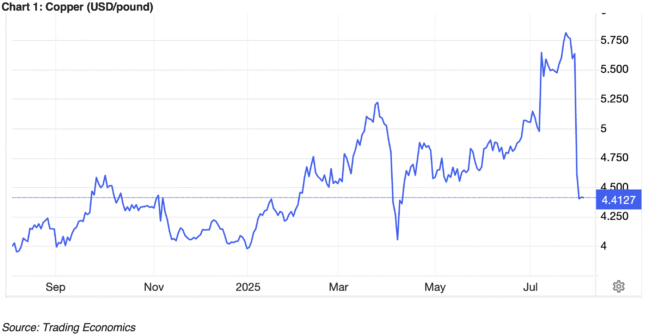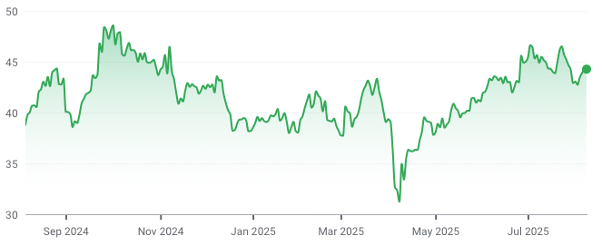All this market fear and irrational selling creates buying opportunities in copper equities. The good news is higher short-term market volatility will create more opportunities to buy irrationally oversold assets. Here’s an ETF I like.
Capitalising on short-term market volatility in the context of a long-term investment framework is the key to delivering attractive returns this decade.
Put another way, investors will have to be more active to boost their portfolio’s total return amid weakening returns from global equity markets.
After two years of 20%-plus returns for US equities, investors could easily become complacent, extrapolating those gains too far into the future. But consecutive annual gains in US equities of that magnitude are rare. Expect returns to be lower from here, or a negative-return year to feature.
Australian equities, too, look fully valued. I can’t see how this market can deliver double-digit returns from here when another year of negative earnings growth looms. We’ll know more this month as the profit season unfolds. I wouldn’t hold out for above-consensus results or bullish outlook statements from companies.
Accompanying lower returns for the rest of this decade will be structurally higher inflation, weighing on purchasing power. Inflation is retreating, although higher energy costs, tariffs and manufacturing reshoring will keep costs higher.
I’m not suggesting equity returns will tumble or that inflation will spike. Rather, that the double-digit returns many investors have become accustomed to in the past few years are probably as good as it gets. One recent retiree told me he assumed a 10% annual return on his portfolio when calculating the longevity of his retirement savings. That’s too bullish.
The good news – depending on your perspective – is higher short-term market volatility will create more opportunities to buy irrationally oversold assets.
In over three decades of covering equity markets, I can’t remember a time when assets have fallen so hard or fast on surprise news.
A confluence of trends is creating unusual price movements. President Trump, a market wildcard, is a source of extreme market volatility. In some cases, the latest Trump utterance can shred asset values by a third or more.
Then there’s the effect of passive investment on money flows. Stocks that enter key share market indices get boosted by a torrent of passive capital, as Exchange Traded Funds buy that stock to replicate its index weighting.
The reverse is also true: when a stock disappoints and falls out of the index, passive funds have to sell it, accelerating its price fall, regardless of company fundamentals.
Algorithmic trading is another factor. Quantitative funds and other traders dump stocks first on the slightest whiff of bad news these days, asking questions later. That helps explain the wide price falls when stocks disappoint.
Capitalising on this volatility – when other investors sell based on fear and momentum rather the fundamentals – requires having portfolio cash to pounce on bargains. It also means having the right portfolio tools: active funds that have a long-term record of exploiting volatility, or ETFs that can be used as asset ‘tilts’.
Copper exposure
Copper is an example of the benefits of capitalising on short-term price volatility in the context of a long-term investment framework. Start with the long term. Copper has been among my preferred metals this decade, principally because I expect growing supply constraints this decade.
Copper is getting hard to find and costlier to mine. One need only read statements from CEOs of leading copper companies to realise how challenging copper mining has become. These constraints will support the copper price.
On the demand side, copper is in Electric Vehicles (EVs) and widely used in solar, wind and other renewable energy systems. These are huge long-term sources of demand for copper as global industry decarbonises. The market finally twigged to copper’s outstanding long-term prospects, driving its price up initially by more than 40% this year, as the chart below shows.

Then came Trump’s tariffs, shown by the sharp fall at the chart’s right. US copper futures last week fell more than 20% in a day – a record drop – after the White House said a 50% tariff would be collected on imported copper products, such as wire and pipes.
The market had expected Trump to impose a 50% tariff on raw copper, which had earlier led to US copper prices surging to record prices in late July. These wild price swings reinforce the opportunities from heightened market volatility that I discussed at the start of this column.
US copper futures have shed almost a quarter of their value since Trump’s latest tariff announcement on the metal. The price is back to levels seen in 2021 and 2022, despite copper’s long-term outlook continuing to improve.
If sustained – and that’s a big ‘if’ with Trump – the tariffs could hurt the copper market in the long run. But fundamentals supporting copper – growing supply constraints and rising demand from renewables – are firmly intact.
Yes, it will take time for tariff-related volatility in the copper price to play out. And yes, uncertainty in the copper market is high, given Trump’s unpredictability. But copper remains a crucial strategic metal, something the White House has commented on this year in its announcements and policy changes.
Adding copper exposure
I view recent large falls in the copper price as an opportunity for long-term portfolio investors to add copper exposure to their portfolio.
Note my emphasis on ‘long term’ – this is an idea for investors with at least a five-year horizon, preferably longer, and ability to withstand price volatility.
Experienced active investors might pinpoint the best copper stocks. When volatility is high, I prefer to use Exchange Traded Funds (ETFs) for asset ‘tilts’. Rather than try to pick the best stocks, I seek broader, diversified exposure to a theme.
The Global X Copper Miners ETF (ASX: WIRE), an ETF I have written positively about before in this column, is a convenient tool for copper exposure.
Bought and sold like a share on ASX, WIRE provides exposure to 40 of the world’s largest copper companies. Its top 10 holdings are a ‘who’s who’ in copper mining.
After strong gains between April and July this year, WIRE’s return this year was crunched after Trump’s tariff plan smashed the copper price.
Over one year to end-July 2025, WIRE has returned only 3%. Over five years, the index on which WIRE is based has a 25% annualised return (to end-June 2025).
Chart 2: Global X Copper Miners ETF

Again, this is consistent with my approach of identifying powerful, durable investment themes, such as copper, and investing in the highest-quality companies exposed to those themes, during times of market dislocation.
Investment purists will argue it’s been easier to buy a handful of undervalued stocks in these themes rather than take an index approach. That requires great skill and has higher potential returns and risks. I prefer using ETFs actively in that instance.
WIRE charges 0.65% annually in fees and is unhedged for currency movements. If, like me, you believe copper has good long-term investment prospects, and that the market has overreacted to Trump’s latest tariff tirade, copper appeals.
In five or 10 years, investors could look back on moments like last week – when copper shed a quarter of its value in a day – as the time to buy.
Tony Featherstone is a former managing editor of BRW, Shares and Personal Investor magazines. The information in this article should not be considered personal advice. It has been prepared without considering your objectives, financial situation or needs. Before acting on information in this article consider its appropriateness and accuracy, regarding your objectives, financial situation and needs. Do further research of your own and/or seek personal financial advice from a licensed adviser before making any financial or investment decisions based on this article. All prices and analysis at 6 August 2025.

